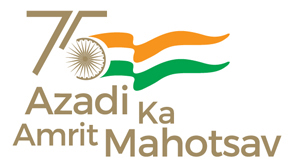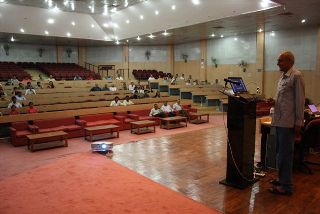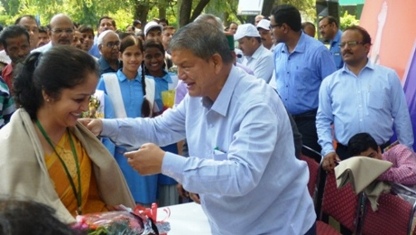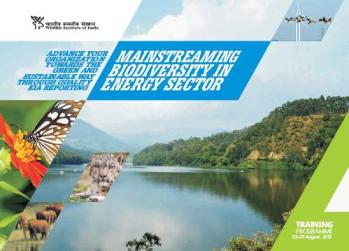Latest Events / News
-
Release of UNESCO C2C Natural Heritage Bulletin
The third issue of the Natural Heritage Bulletin published by UNESCO C2C, WII was launched on 22nd October, 2015 during the concluding session of the United Nations Intergovernmental Platform on Biodiversity and Ecosystem Services (UN-IPBES) Conference held at WII, Dehradun. The honours was done by Mr. Zakri Abdul Hamid, Chair, IPBES and facilitated by Dr. V. B. Mathur, Director, WII.
The Bulletin is a compilation of news and information on World Natural Heritage Sites in the Asia-Pacific Region. Among key events covered in this issue over the last quarter, viz. July – September 2015, include the 39th Session of the World Heritage Centre at Bonn, appointment of a new Director of World Heritage Centre, respite for Australia’s Great Barrier Reef from the ‘in Danger’ list, extension of the Phong Nha-ke Bang property of Vietnam, International Workshop on Natural Heritage and Disaster hosted by C2C at WII in August 2015 among others.
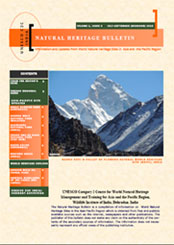
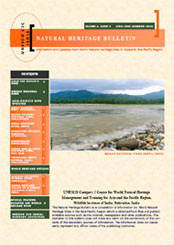
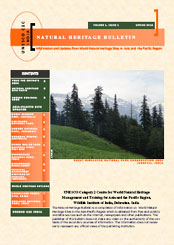
Last Updated: October 28, 2015 -
Himalaya Day celebrated at the Wildlife Institute of India, Dehradun, 9th September 2015.
Over 250 members of WII, including eminent scientists, wildlife managers, researchers and students of wildlife sciences celebrated ‘Himalaya Day’ in Wildlife Institute of India. People of Uttarakhand are aware that on this day in the year 2010, a group of environmentalists and civil society members led by Dr. Anil Joshi urged the government to formulate a focused policy for saving the Himalaya and its people. Following this, a manifesto was prepared and submitted to the government based on a year-long nation-wide debate and discussions. Since then, this day is celebrated as 'Himalaya Day' to spread the message that solutions for sustainable development and ecological stability for the Himalayas must be as unique as the Himalayan ecosystem itself. The state government has officially declared September 9 as ‘Himalaya Diwas’ – a day which will be celebrated across the State to spread the message of conservation of the Himalayan ecosystems. The focal theme for the year 2015 is "Sab ka Himalaya".
Dr. V. B. Mathur, Director, Wildlife Institute of India, Dehradun, stated that the institute has been observing the Himalaya Day every year since 2011 and for this year we had invited Prof. Shekhar Pathak, a noted historian, writer, orator and naturalist for talk on 'Kailash- Manas Prakruti and Sanskriti" at the institute. The talk was held in WII Auditorium which was attend by all employees participated. Dr. Shekhar Pathak is an Indian historian, writer and academician from Uttarakhand. He is a former professor of History at Kumaun University, Nainital and a Nehru Fellow at the Centre for Contemporary Studies at Teen Murti in New Delhi. He was awarded the Padma Shri by Govt. of India, in 2007. In his elaborate talk, he mentioned about ‘Kailash-Mansarovar Yatra’ and the natural and cultural values of this landscape. Holding significance for the Hindus as the abode of Lord Shiva, it holds religious importance also for the Jains and the Buddhists. Three of the world's major rivers—the Indus, the Ganges and the Brahmaputra—arise in the Himalayas. While the Indus and the Brahmaputra rise near Mount Kailash in Tibet, the Ganges rises in the Indian state of Uttarakhand. Their combined drainage basin is home to some 600 million people. The indigenous people living in eastern Uttarakhand, western Nepal and southern Tibet and the rich and diverse flora and fauna are all an integral part of this landscape that needs to be conserved and managed through trans-boundary cooperation.
Taking this into consideration, the governments of India, China and Nepal have come together to work towards the common conservation and sustainable development goals in the Kailash Sacred Landscape that is coordinated by ICIMOD said Dr. P.K. Mathur, Dean, WII
The unique floral and faunal wealth of the Himalayas is undergoing structural and compositional changes due to climate change. The increase in temperature is shifting various species to higher elevations. There are reports of early flowering and fruiting in some plant species said Dr. G.S. Rawat, Senior Scientist, WII.
These facts reflect that the Himalayas have been soul of the country by virtue of cultural, ethnic, ecological and economical values. It has not been guarding country’s border only but constantly serving its human by enriching soil, air, water etc. Unfortunately importance of Himalayas was always underestimated for its integral role in overall development of the Nation. Deterioration of Himalayan system due to inadequate attention has threatened our Life Supporting Resources. Status of forest, water, air soil has become alarmingly grim.
But, we must not forget that the Himalayas are our greatest heritage. They are storehouses of biodiversity and natural resources which have sustained life in the mountains as well as the plains for centuries.
“From time immemorial, Himalaya is the sacred place for all the communities living in Gangetic plains and Tibetan plateau. About 60 million people depend on Himalaya for their day-to-day activities and livelihoods. The diversity of life as well as human communities are unique in Himalaya. In this era of rapid transformation, we need to understand and mitigate the loss of Himalayan ecosystem.” told by Prof. Pathak in his elaborate talk.
The Himalayan states and its people definitely need economic growth, but the planners and policy makers in New Delhi and the state capitals of the Himalayan states should take special care that development and economic growth takes into account the ecology and the fragility of the region.
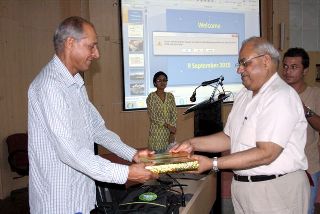
Last Updated: September 11, 2015 -
Dr. Ruchi Badola been felicitated by the Chief Minister of Uttarakhand on the occasion of Himalaya day for her scientific contribution towards conservation of Himalayan Ecosystem
Last Updated: September 11, 2015 -
Release of report ‘Management Effectiveness Evaluation’ (MEE) of National Parks and Wildlife Sanctuaries in India 2006- 2014
 Shri Prakash Javadekar, Minister of State (Independent Charge) Environment, Forest & Climate Change, Government of India released the MEE report of National Parks and Wildlife Sanctuaries 2006 to 2014 on 2nd September, 2015. He expressed happiness on the overall performance of the protected areas and urged the park managers to continue their efforts for conserving the biological richness of the country.
Shri Prakash Javadekar, Minister of State (Independent Charge) Environment, Forest & Climate Change, Government of India released the MEE report of National Parks and Wildlife Sanctuaries 2006 to 2014 on 2nd September, 2015. He expressed happiness on the overall performance of the protected areas and urged the park managers to continue their efforts for conserving the biological richness of the country.
The Management Effectiveness Evaluation (MEE) process is a global framework to evaluate the performance of protected areas. India is among the select countries in the world that has institutionalized the MEE process for its network of protected areas. The Ministry of Environment, Forest and Climate Change (MoEFCC) and the Wildlife Institute of India (WII) has got independently evaluated 125 national parks and wildlife sanctuaries in the country from 2006 to 2014. Despite all odds, the overall outcomes of these assessments are encouraging and the mean MEE score of the Indian protected areas is 60.80%, which is higher than the global mean of 56 percent.
The WII-MEE team comprised of: Dr. V.B. Mathur, Shri V.K. Uniyal, Shri P.C. Tyagi, Shri Aseem Shrivastav, Dr. A.K. Bhardwaj, Dr. Dhananjay Mohan, Shri Shubharanjan Sen, Shri Ajay Srivastav, Dr. Pratap Singh and Shri Nasim Ahmad Ansari.
Download MEE Report
 (32 MB)
(32 MB)Plug-in: Download Adobe Acrobat Reader
Last Updated: November 16, 2015 -
6th Asia Regional Conservation Forum
Resilience in Action: Creating Solution for people and nature

The 6th Asia Regional Conservation Forum (RCF) was held in Bangkok from 10-12 August, 2015 where 500 representatives of NGOs, Government and business sector from across Asia gathered together to discuss how they can work together to deal with Asia’s environmental issues and share their experiences
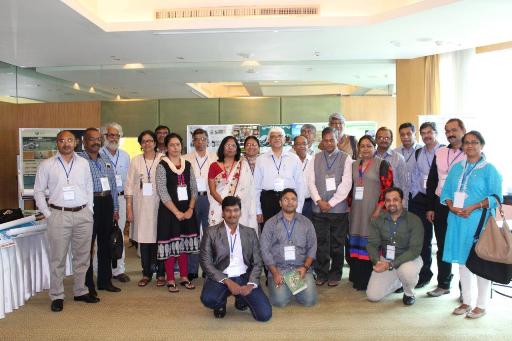
Twenty participants from India representing NGOs & Government participated in the RCF. 
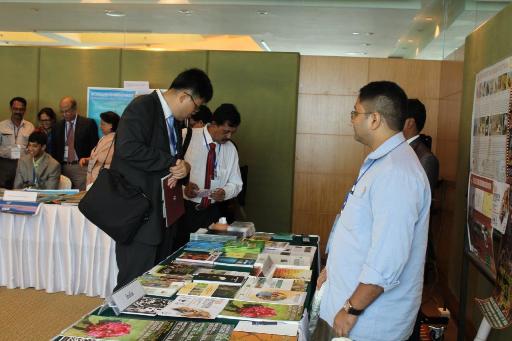
An exhibition depicting the publications, posters and films of the members of the Indian National Committee of IUCN was set up during the RCF. 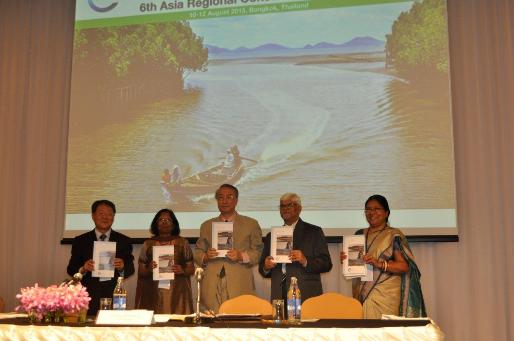
The Indian National Committee of IUCN produced an Annual Report of the activities of its members for the year 2014-15. The Annual Report was released on the first day of the RCF by Mr. Zhang Xinsheng, IUCN President, Professor Youngbae Suh, Former Chair of the IUCN Asia Regional Member’s Committee in the presence of Ms. Meena Gupta, Vice Chair of the Governance and Constituency Committee, Sh. Vinod Ranjan, ADG (WL) and Dr. Bitapi C. Sinha, Coordinator, INC-IUCN. - Annual Report 2014-15
 (13 mb)
(13 mb)
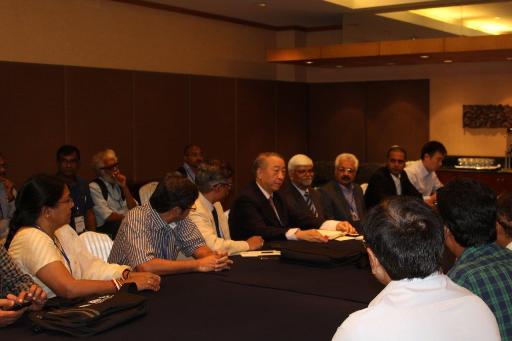
On the last day of the RCF, Mr. Zhang Zinsheng, IUCN President met the members of the Indian National Committee of IUCN. IUCN President appreciated the efforts of the Indian National Committee and discussed issues which required focus during the World Conservation Congress at Hawai in 2016. 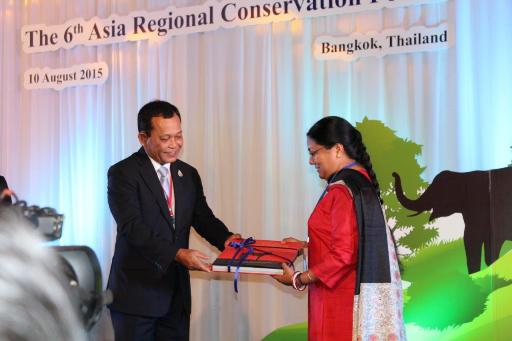
RCF organized a photo contest. Mr. Nilanjan Chatterjee of the Wildlife Institute of India won the first prize in the individual category for his picture. The award was received on his behalf by Dr. Bitapi C. Sinha from Thailand’s Minister of Natural Resource.
Last Updated: August 18, 2015 - Annual Report 2014-15
-
3rd DST-SERB School in Herpetology (Second Phase) 1-15 October, 2015
Last Updated: August 5, 2015 -
Launch of the UNESCO C2C E-Bulletin (second issue) at the 39th Session of the World Heritage Committee at Bonn, Germany
 The second issue of the Natural Heritage Bulletin was launched on 3rd July, 2015 in a meeting of the focal points of C2C s at the 39th Session of the World Heritage Committee at Bonn. Speaking on the occasion Dr V.B.Mathur, Director WII gave a presentation on the activities of the UNESCO Category 2 Centre for World Natural Heritage Management and Training for Asia and the Pacific Region, Wildlife Institute of India. He was representing the Indian Delegation that comprised of senior officials from Ministry of Environment and Forests & Climate Change and Archeological Survey of India.
The second issue of the Natural Heritage Bulletin was launched on 3rd July, 2015 in a meeting of the focal points of C2C s at the 39th Session of the World Heritage Committee at Bonn. Speaking on the occasion Dr V.B.Mathur, Director WII gave a presentation on the activities of the UNESCO Category 2 Centre for World Natural Heritage Management and Training for Asia and the Pacific Region, Wildlife Institute of India. He was representing the Indian Delegation that comprised of senior officials from Ministry of Environment and Forests & Climate Change and Archeological Survey of India.The second issue of the Natural Heritage Bulletin is a Disaster Risk reduction (DRR) special and also has a compilation of news and information on World Natural Heritage sites in the Asia-Pacific Region.
Download E-Bulletin
 (3.65 mb)
(3.65 mb)
Last Updated: July 20, 2015 -
EIA Training Programme on "Mainstreaming Biodiversity in Energy Sector" (August 3-5, 2015)
Last Updated: June 30, 2015 -
International Workshop and Training on the Role of Natural World Heritage Sites in Disaster Risk Reduction (August 24-28, 2015)
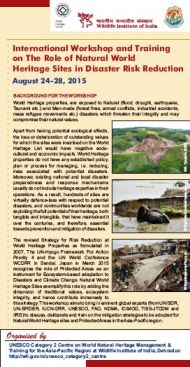 Download Flyer
Download Flyer  (8.21 mb)
(8.21 mb)
Last Updated: June 26, 2015 -
Celebration of International Yoga Day
The Wildlife Institute of India’s faculty, staff, research and students and their families joined over 600 participants of the Dehradun-based institutions led by the Indira Gandhi National Forest Academy (IGNFA) on the sprawling sports ground of IGNFA and in the august presence of Shri Prakash Javadekar, Minister of Environment, Forest & Climate Change (MoEF&CC), Government of India on 21 June, 2015 to celebrate the International Yoga Day. Yoga asanas and pranyams were performed under the guidance of trained yoga instructions.
‘Yoga is not about exercise but to discover the sense of oneness with yourself, the world and the nature’ said the Prime Minister Shri Narendra Modi during his maiden speech in United Nations General Assembly in 2014 after which the celebrations of International Day of Yoga on 21 June, 2015 was declared by the United Nations.
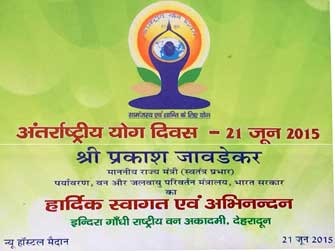
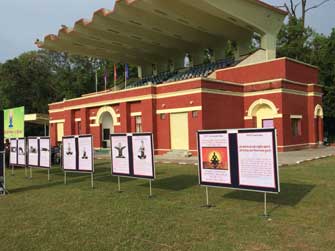
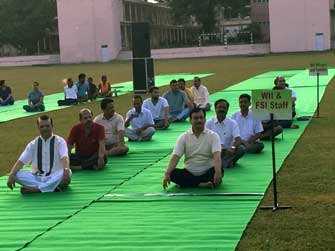
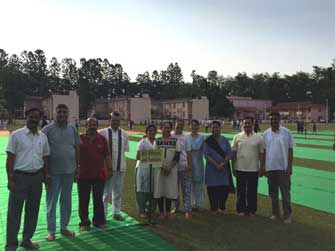
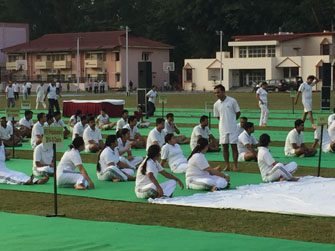
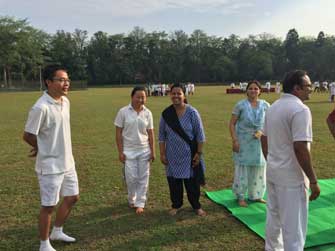
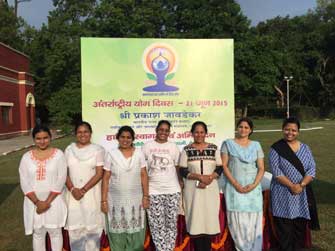
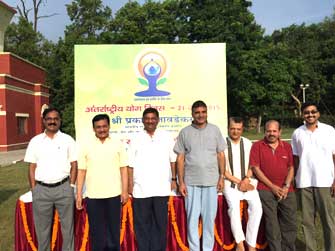
Last Updated: November 22, 2022

